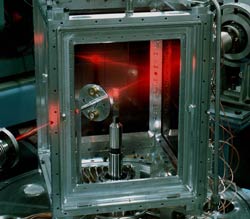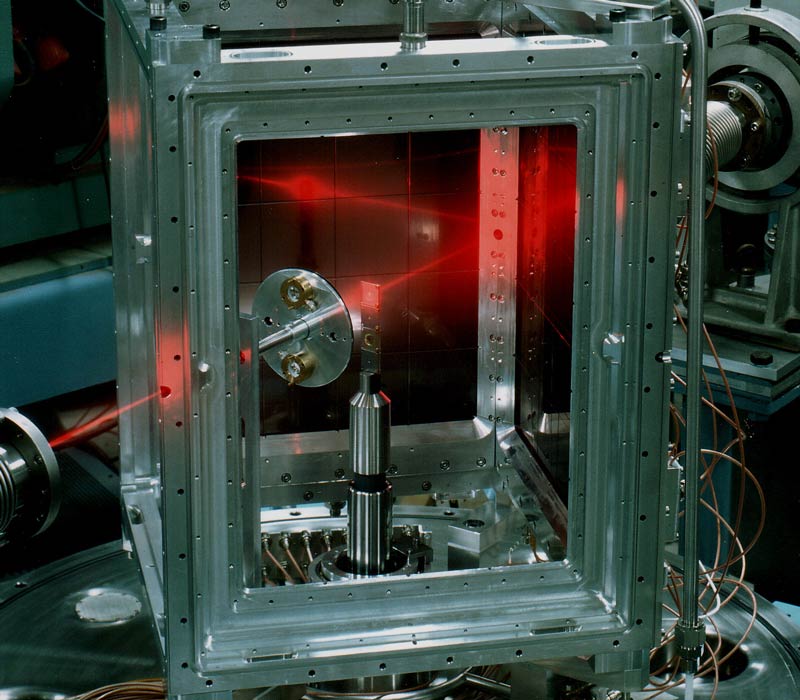Nuclei in Collision
When two large nuclei collide and fuse–rather than flying apart–some of the credit goes to the internal motions of protons and neutrons that result in excited states of the nuclei. The best models account for these states in calculating the fusion rate. But in the 9 November Physical Review Letters, Australian physicists say their measurements disagree with even these sophisticated models. The researchers suggest that the internal modes get out of synch even while the collision is underway, so that the nuclei behave more like a macroscopic classical object than a tiny quantum one.
Two nuclei can overcome the “Coulomb barrier” of repulsion of like charges and fuse if they approach fast enough. Nuclei with less energy ordinarily bounce off without fusion, but occasionally they “tunnel” through the barrier in a purely quantum-mechanical process. In recent decades, however, improved measurements of this “sub-barrier” fusion showed a surprise for large nuclei: “people found that the probability of fusion below the Coulomb barrier is 10 to 1000 times more than what you would expect,” says Mahananda Dasgupta of the Australian National University in Canberra.
To explain this enhanced fusion, theorists have invoked the excitation of the nucleus to higher energy states, which were neglected in the simplest theories. Even if two nuclei start out in their lowest quantum states, they can evolve into a mixture of these excited states, resulting in a lower barrier that promotes fusion. The theory explained the data and “was quite a triumph,” Dasgupta says.
Now, however, she and her colleagues have extended the experiment, measuring a nearly 100-million-fold decrease in the fusion rate as they lowered the energy of the approaching nuclei from well above the barrier to well below it. For the experiment, they smashed oxygen-16 into lead-204 and -208, the heaviest nuclei ever measured so far below the barrier. But they found that the parameters that describe the data above the barrier don’t match the results well below it. Earlier researchers had spotted a similar discrepancy for lighter nuclei like nickel [1].
The team speculates that this discrepancy results from a loss of coherence, or quantum phase relationship, between fusion pathways involving different energy states of the nuclei. In a more familiar example, light hitting two slits in a screen interferes on the other side. At any spot on a more distant screen, the light is brighter or dimmer depending on the phases of light from the slits. But if you set up a detector to identify which slit each photon of light goes through, the photon loses phase coherence and acts like a classical particle with no interference effect.
Similarly, in many fusion models there is a point at which the combined nuclei “commit” to the final, fused state, much as a photon commits to one slit or the other when the detector is in place. This commitment should also disrupt the interference between pathways that would otherwise enhance fusion, according to Dasgupta and her colleagues, although they don’t yet have a mathematical description.
Loss of coherence is a major problem for quantum computer designs, and the team says their data may provide new insights because the interactions that lead to coherence loss are entirely within the nuclei, rather than the less controlled world of the lab.
Henning Esbensen, of Argonne National Laboratory in Illinois, says that he and a collaborator have modified the traditional theory to account for the fusion data but that the experiments are an important contribution. “This is very nice data,” agrees A. Baha Balantekin of the University of Wisconsin in Madison. “It’s up to us [theorists] now to understand what it means and how to describe it.”
–Don Monroe
Don Monroe is a freelance science writer in Murray Hill, New Jersey.
References
- C. L. Jiang et al., “Influence of Nuclear Structure on Sub-Barrier Hindrance in Ni + Ni Fusion,” Phys. Rev. Lett. 93, 012701 (2004)





